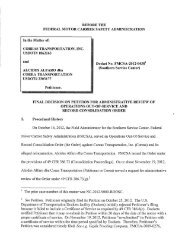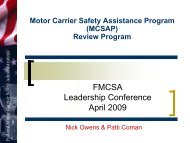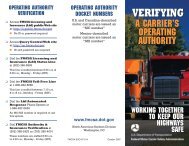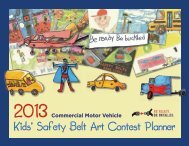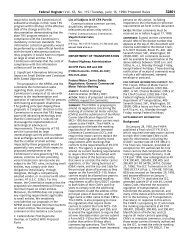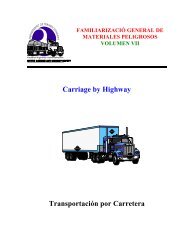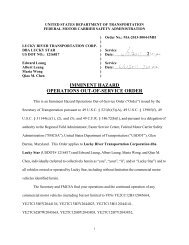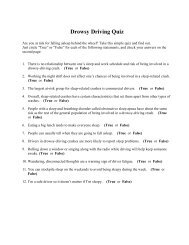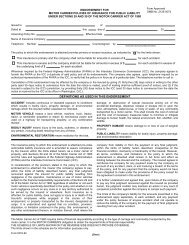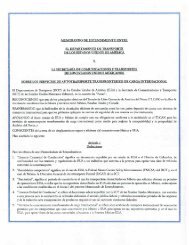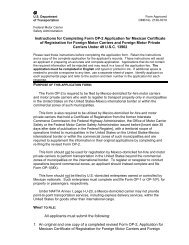Bilingual Hazardous Materials General Awareness Training ...
Bilingual Hazardous Materials General Awareness Training ...
Bilingual Hazardous Materials General Awareness Training ...
You also want an ePaper? Increase the reach of your titles
YUMPU automatically turns print PDFs into web optimized ePapers that Google loves.
BILINGUAL<br />
HAZARDOUS MATERIALS<br />
GENERAL AWARENESS TRAINING<br />
Volume IV<br />
PLACARDING<br />
CARTELES
The format for the material contained herein was developed using Presentation Task<br />
Force and Corel Draw, WordPerfect, and Presentations.<br />
The editors of this material and the Federal Highway Administration make no<br />
representation as to the accuracy of the Spanish translation contained herein. The<br />
material contained in this presentation is for general information and training<br />
purposes only. To determine specific regulatory requirements, consult the most<br />
current copy of 49 Code of Federal Regulations Parts 100-185.<br />
Los redactores de este material y la Administración Federal de Carreteras no hacen<br />
ninguna representación en cuanto a la exactitud de la traducción Española que se<br />
contenga aqui dentro. El material que está contenido en este folleto es para<br />
propósitos de capacitación solamente. Para requisitos específicos, favor de leer 49<br />
Código de Reglamentos Federales Partes 100-185.<br />
IV-ii<br />
10/01/98
First, we'll look at the basic placarding requirements. Then, we'll look at some of<br />
the "unless otherwise provided" exceptions and options.<br />
Placarding Table 1.<br />
Category of material<br />
(Hazard class or division<br />
number and additional<br />
description, as appropriate<br />
Placard Name<br />
PLACARDING IV-1<br />
Placard design<br />
section<br />
reference ()<br />
1.1........................................... EXPLOSIVES 1.1................ 172.522<br />
1.2........................................... EXPLOSIVES 1.2............... 172.522<br />
1.3........................................... EXPLOSIVES 1.3............... 172.522<br />
2.3.......................................... POISON GAS...................... 172.540<br />
4.3.........................................<br />
6.1 (PGI, inhalation<br />
DANGEROUS WHEN WET 172.548<br />
Hazard only)................. POISON............................... 172.554<br />
5.2 (Organic peroxide, Type ORGANIC PEROXIDE...<br />
B, liquid or solid<br />
Temperature controlled<br />
7 (RADIOACTIVE<br />
YELLOW III LABEL<br />
172.552<br />
ONLY).............................. RADIOACTIVE............................ 172.556<br />
Any quantity of any hazardous material listed in Table 1 requires placarding.<br />
172.504(a)<br />
172.504(a)
Placarding Table 2 lists the remainder of the hazardous material classes that require<br />
placards. However, Table 2 material requires placarding only when the aggregate<br />
gross weight of all Table 2 hazardous materials on the transport vehicle or in the<br />
freight container is 1,001 pounds or more.<br />
Transport vehicles and freight containers transporting less than 1,001 pounds gross<br />
weight of Table 2 material MAY be placarded. Placards are not required.<br />
Category of material<br />
(Hazard class or division<br />
number and additional<br />
description, as appropriate)<br />
PLACARDING IV-2<br />
Placard Name<br />
Placard design<br />
section<br />
reference ()<br />
1.4........................................................ EXPLOSIVES 1.4....................................... 172.523<br />
1.5........................................................ EXPLOSIVES 1.5........................................ 172.524<br />
1.6........................................................ EXPLOSIVES 1.6........................................ 172.525<br />
2.1......................................................... FLAMMABLE GAS................................... 172.532<br />
2.2......................................................... NON-FLAMMABLE GAS......................... 172.528<br />
3............................................................ FLAMMABLE............................................ 172.542<br />
COMBUSTIBLE LIQUID................ COMBUSTIBLE......................................... 172.544<br />
4.1......................................................... FLAMMABLE SOLID............................... 172.546<br />
4.2......................................................... SPONTANEOUSLY<br />
COMBUSTIBLE.......................................... 172.547<br />
5.1......................................................... OXIDIZER...................................................... 172.550<br />
5.2.Other than Type B liquid or solid<br />
6.1(PG I or II (other than PG I<br />
ORGANIC PEROXIDE................................ 172.552<br />
Inhalation hazard)........................ POISON.......................................................... 172.564<br />
6.1 (PG III )......................................... KEEP AWAY FROM FOOD....................... 172.563<br />
6.2......................................................... NONE............................................................ ............<br />
8............................................................ CORROSIVE................................................ 172.558<br />
9............................................................<br />
ORM-D........................................<br />
CLASS 9...................................<br />
NONE........................................<br />
172.560<br />
............<br />
Exceptions and options are provided in sub-sections f and g of 172.504. In<br />
placarding Table 2, weight is only one of the factors to consider.<br />
172.504(c)(1)<br />
172.504(a)
If a transport vehicle or freight container carries two or more hazard classes from<br />
Table 2 requiring different placards, the DANGEROUS placard may be used in<br />
place of the hazard class placards.<br />
172.504(b)<br />
THE DANGEROUS PLACARD MAY BE<br />
USED FOR TWO OR MORE TABLE 2<br />
MATERIALS<br />
The specific Table 2 placard must be used when 1,000 kilograms or more of one<br />
class of hazardous material is loaded at one loading facility. In this case, the<br />
DANGEROUS placard may not be used.<br />
PLACARDING IV-3<br />
1,000 kg (2,205 lbs.) Or<br />
More Of One Class<br />
Loaded At One Location<br />
Must Be Placarded For<br />
That Hazard Class
No Dangerous Placard<br />
on Cargo Tanks<br />
No Dangerous Placard<br />
on Cargo Tanks!!<br />
Subtitle of Show<br />
The DANGEROUS placard may not be used on a cargo tank, portable tank or tank<br />
car. Instead, the specific placard for each hazardous material must be applied. In<br />
addition, the DANGEROUS placard may not be used for placarding Table 1<br />
material.<br />
PLACARDING IV-4<br />
172.504(a)-(b)
Does Not Apply To:<br />
Tank Cars<br />
Cargo Tanks<br />
Portable Tanks<br />
Poison Inhallation Hazard <strong>Materials</strong><br />
Air and Water Shipments<br />
No placard is required for Table 2 material when the gross weight is less than 1,001<br />
pounds.<br />
However, you must placard Table 2 material when shipped:<br />
- in portable tanks, cargo tanks or tank cars;<br />
- by air or water; or<br />
- in transport vehicles and freight containers carrying material identified on a<br />
shipping paper as a "Poison-Inhalation Hazard."<br />
PLACARDING IV-5<br />
172.504(c)
Must Remain Placarded Unless<br />
Cleaned and Purged or Loaded<br />
with Non-<strong>Hazardous</strong> <strong>Materials</strong><br />
Each cargo tank or portable tank required to be placarded when it contained a<br />
hazardous material MUST remain placarded when it's emptied.<br />
The placard MUST be removed if the tank is reloaded with a nonregulated material.<br />
The placard MUST be removed once the tank is cleaned and purged of all<br />
potentially hazardous vapors.<br />
172.514(b)<br />
PLACARDING IV-6<br />
Must be<br />
Displayed<br />
Each placard on a motor vehicle or rail car must be readily visible from the direction<br />
it faces. Placards must be on each side and each end. If coupled to another motor<br />
vehicle or rail car, visibility is not required from the direction it faces. For example,<br />
this tractor semi-trailer has the placard affixed to the front of the trailer but the cab<br />
blocks the placard from view. This is permitted.<br />
172.516(a)
Subtitle of Show<br />
PLACARDING IV-7<br />
OR<br />
49 CFR 172.516<br />
The required placard on the front of a motor vehicle may be on the front of a truck<br />
tractor instead of, or in addition to, the placard on the attached cargo body.<br />
172.516(b)<br />
If visibility requirements are met, freight containers or portable tanks may be<br />
placarded instead of the motor vehicle. But, if a portable tank or freight container<br />
requiring placarding is inside a transport vehicle, the van type trailer must be<br />
placarded. By D.O.T. interpretation loads may be placarded instead of the vehicle<br />
as long as the visibility requirements are met.
Each placard must be securely attached and maintained in good condition.<br />
Placards must be located clear of appurtenances and devices, away from dirt and<br />
water from wheels and at least three inches from any detracting markings.<br />
Placard words and/or numbers must be displayed horizontally.<br />
PLACARDING IV-8<br />
172.516(c)
There are some special placarding requirements that the shipper, carrier or<br />
warehouse person must follow. For example:<br />
A PIH material also needs the poison or poison gas placard.<br />
When a shipping paper describes a material as a "poison inhalation hazard" the<br />
poison placard is required. The placard must be displayed on each side, on the<br />
front, and on the back of the transport vehicle, portable tank, or freight container.<br />
This placard is required in addition to any other required placards.<br />
PLACARDING IV-9<br />
OR



